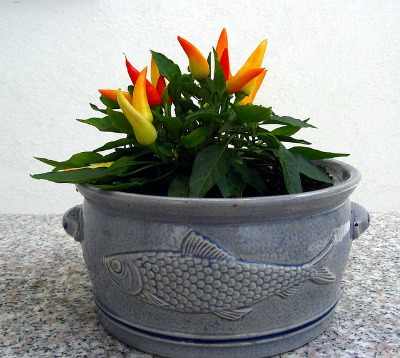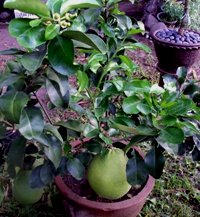Pot gardening or container gardening is the growing of plants, singly or in a group, exclusively in pots or containers rather than directly on the ground.
This method is ideally suited for urban farming where planting ground is limited or unavailable.
It is generally applied for houseplants and is also useful in areas where the soil or climatic conditions are not suitable for a particular crop.

Potted plants can be grown on porches, front steps, walls, along driveways and pathways, inside the house, on tabletops, rooftops, near the kitchen, and anywhere else.
Any pot or container can be used. It may be a barrel, tub, planting box, bowl, urn, tin can, hanging basket, or anything that can hold soil.
It may be made of metal, clay, stone, concrete, wood, rubber, plastic, or hard parts of plants and animals like the shell of the coconut and some shellfish.
The choice is unlimited, subject only to such considerations as availability, durability, cost, aesthetic effect, and the number as well as the maximum sizes of the plants to be grown.
Other Advantages of Pot Gardening
1. Flexibility
Potted plants can be moved from one location to another in the garden or house where they will grow best or give the most appealing effects.
They can be moved vertically and horizontally to experiment with new garden designs and to create new effects.
2. Space Shaping
Potted plants can be used to shape and define selected parts of the landscape such as seating areas, paths, and entryways.
A planted container between the garden and a walkway will provide a pleasing transition between spaces.
Potted miniatures and certain flowering plants can serve as accents.

3. Ease in Culture
Plants can be grown with the best potting medium, prepared by mixing the appropriate ingredients.
There is less risk of soil-borne diseases and weeds can be easily eliminated. Where any plant is infested or diseased, it can be easily removed for treatment.
4. Mobility
Growing plants in containers allow the creation of mobile pot gardens.
Potted plants can be transferred to new locations whenever there is a need to change residence.
Steady Supply of Food and Medicine Thru Pot Gardening
Both land plants and aquatic plants can be grown in containers. These plants include cash crops and both food and non-food crops.
The advantage of pot gardening, however, is best exploited by the urban poor for the purpose of food production and cash generation.
A steady supply of fresh and nutritious food for the family can be ensured by growing potted vegetables (e.g. eggplant, jute or saluyot, malunggay or horseradish tree, peppers, pigeon pea or kadyos), fruits (e.g. citrus, guava, sapodilla, sugar apple, tambis or bell fruit) and culinary herbs (e.g. basil, lemongrass, onions, anise, fragrant screwpine or pandan).
In addition to food crops, the growing of potted medicinal plants will also generate cash savings.
Clinically proven medicinal plants include ampalaya (charantia), guava, lagundi (five-leaved chaste tree), tsaang gubat (Ehretia microphylla), and yerba buena.
Both ampalaya and guava can be grown as sources of food and, at the same time, as emergency sources of herbal medicine.
For landscaping, the advantage of container or pot gardening is without limit.
A collection of food crops and medicinal plants will easily arouse curiosity.
A potted tomato or pepper with ripe fruits is wonderful to see, as with an acapulko (ring-worm bush) profuse with yellow flowers.
These plants will likewise become useful as filler where there are vacant spaces in the landscape.
References
Bix, C. and The Editors of Sunset Books. Container Gardening. 1998. Menlo Park, CA: Sunset Publishing Corp. 112 p.
Iannotti, M. undated. Top 10 tips for great container gardens. Retrieved September 9, 2010, from http://gardening.about.com/od/gardendesign/tp/ContainerGarden.htm.
Weldon Owen Pty. Ltd. 2003. The Essential Gardening Encyclopedia. San Francisco, CA: Fog City Press. pp. 210-277.
Wikipedia. 2010. Container garden. Retrieved September 9, 2010, from https://en.wikipedia.org/wiki/Container_garden.
